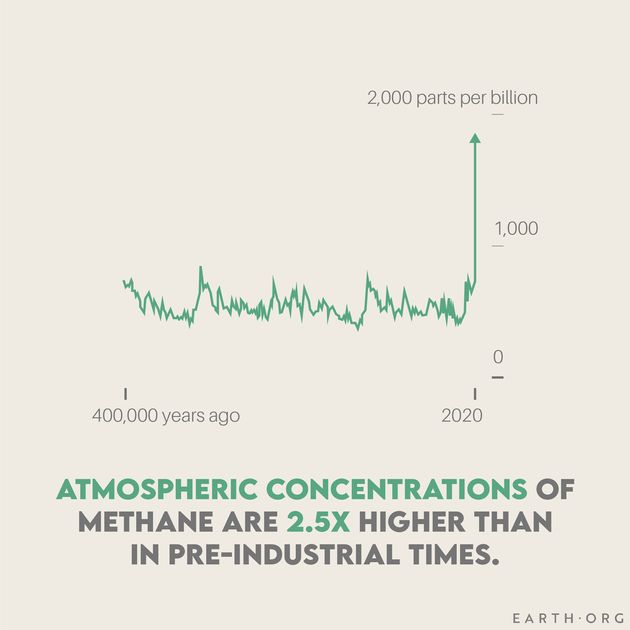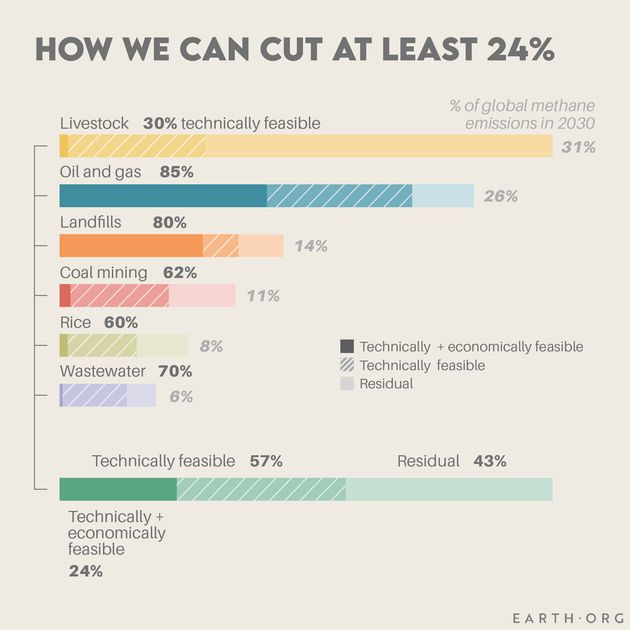Over 100 countries signed an agreement to cut methane emissions by at least 30% by 2030, though the three largest emitters, India, Russia and China, did not join. Here, we explain why the agreement was such as important one, and how it could seriously curtail short-term global warming.
—
We’d freeze to death without the greenhouse effect (or just not exist at all), but thanks to heat-trapping molecules in the atmosphere, we live in an agreeable 14C average-temperature world.
Unfortunately, it so happens that the fossilized carbon fuels we use to drive our engines also release greenhouse gases, slowly but surely disrupting the benign 12,000 year climate that allowed humans to thrive.
Carbon dioxide is seen as the most important of these gases, despite it absorbing less heat per molecule than most of the others. This is because it lingers in our atmosphere for centuries longer, therefore committing us and the next generations to more warming.
We now find ourselves running out of precious time to meet the Paris Agreement’s goal of staying under 1.5C, a threshold we will probably cross within a decade. The carbon dioxide we’ve emitted might already be enough to take us past it, if not within 10 years, then within the centuries it has left up there.
This is why the international community has ended its tunnel-vision on CO2 and brought the Global Methane Pledge to life with 103 signees. Methane has been increasing just as relentlessly as CO2, with a higher potential to snowball out of control.

It is commonly described as having 28-34 times the warming potential of CO2, but this is a little misleading. With a 12-15 year lifespan, methane traps around 80 times the heat CO2 does over 20 years, dropping to 28-34 times over a century, the standard timescale.

Indeed, limiting methane emissions could be an excellent solution to effectively curtail short-term warming. A recent study led by Ilissa Ocko of the Environmental Defense Fund found that there are many available, yet underutilized strategies to reduce methane emissions throughout a range of industries.

According to them, pursuing all of the technically feasible measures now could slow warming by 30% in the next decade. On geological timescales, that is near-immediate impact, and the authors argue it is far preferable to the current focus on long-term, carbon-centered policies.
In fact, action towards limiting methane emissions is likely to be slowed or delayed while decarbonization and net-zero are given priority, despite the former’s feasibility and the latter’s unclear outcome.
Admittedly, methane has benefited from a lack of visibility to escape governmental action. In the oil and gas industry, its emissions are often fugitive, unintentionally leaked out of fossil fuel infrastructure and poorly quantified. Similarly, those from landfills are significant, yet poorly monitored.
If crude measurement techniques were to blame, satellite technology has come and changed the game. Academic, private and non-governmental organizations can now access a literal eye in the sky to flag undeclared or underestimated methane sources.
Researchers from Harvard found that emissions in Texas and New Mexico were twice government figures, while the french satellite analysis company Kayrros SAS flagged a huge methane leak from a Russian pipeline owned by Gazprom just a few weeks ago.
Armed with these tools, governments have everything they need to take decisive action. The payoff is a potential 0.2°C less warming by 2050, which could give many vulnerable nations a much needed reprieve as they adapt to climate change.
This article was written by Owen Mulhern.
You might also like: An Update to Food Waste Statistics










![The Statistics of Biodiversity Loss [2020 WWF Report]](https://u4d2z7k9.rocketcdn.me/wp-content/uploads/2020/12/lprwinkyTHB-544x306.jpg)





